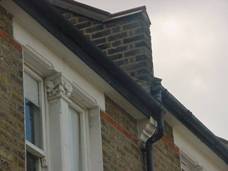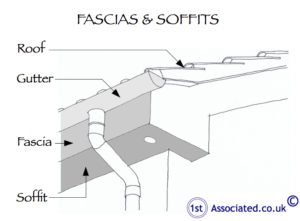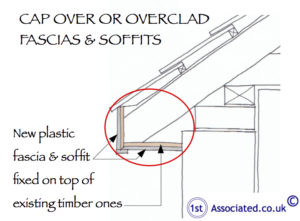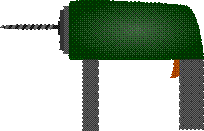Problems with fascia and soffit boards
 1stAssociated can provide help and advice with regard to building surveys, structural surveys, independent valuations, property surveys, structural reports, engineers reports, specific defects report, home buyers reports or any other property matters. As you can see from this article we use lots of sketches and photos in our reports as the feedback we have from our clients is that the sketches and photos help them understand the reports.
1stAssociated can provide help and advice with regard to building surveys, structural surveys, independent valuations, property surveys, structural reports, engineers reports, specific defects report, home buyers reports or any other property matters. As you can see from this article we use lots of sketches and photos in our reports as the feedback we have from our clients is that the sketches and photos help them understand the reports.
We, of course, like to meet you at the property during the survey and we are more than happy to talk to you about the reports.
Please free phone 0800 298 5424 for a friendly chat with one of our surveyors.
Free phone 0800 298 5424
What are fascia and soffit boards?


Fascia and soffits boards are the boards that sit at the very bottom of a roof or the perimeter of the roof and are sometimes used as the fixing board for the guttering.
Then they are usually forgotten about!
Why did we start using fascia and soffit boards?
Years ago our main roof finishes were thatch. As such, the junction of the end of the roof where it met the wall was sealed. The thatch projected over the front of the wall and therefore any rainwater that came to the end of the thatch dripped away without causing any damage to the property. However, as building progressed and we started to use clay tiles and then slates for the roof, the roof still needed to over project the walls to keep the rainwater away.
Fascias and soffit boards were used to fill up the gap between the wall and the roof, although we have seen some roofs that sit almost directly on top of the wall. The only problem with these is that if the gutters leak they leak into the top of the wall, which gradually becomes saturated and is only usually visible when it is a big problem.
Fascias and soffit boards are often used for the guttering to be fixed to, which unfortunately in turn hides the fascia board. We always remember the boards in the following way: the fascia board faces you, the soffit board is the other one!
Free phone us on 0800 298 5424
What does your fascia and soffit board say about you?
Traditionally, fascias and soffit boards would have been painted timber. As they are at high level and out of the way they generally, as we have mentioned already, tend to be forgotten about. By forgotten about we mean that they are never decorated.
Surveyors generally note where the paint is flaking on a fascia and soffit board, as this means there are problems with the guttering. It normally means the fascias and soffits boards have rotted away as well, as they tend to be made from cheaper soft wood in the more modern properties (by modern we mean in this case after the war years).
No more maintenance with plastic fascias and soffit boards!
Often marketed as no more maintenance required, plastic fascias and soffits boards seem to be the answer to the need to re-paint the awkwardly positioned (usually two storeys up) fascias and soffits boards, which in reality very rarely get painted, due to people's fear of heights, or just lack of looking up.
It can sometimes be carried out on its own, more often it is carried out as an afterthought when gutters and downpipes are replaced, or the new windows are put in the property, or even when a conservatory is added.
It looks the same but overcladding or cap over is very different to having the fascia and soffit board replaced properly
Overcladding is basically where thin plastic is put over the top of the existing timber. It doesn't resolve the problem at all, what it does is merely hide the problem. In fact, it can be argued that it makes the problem worse as it traps in any moisture, which can cause the timber to rot much quicker.
Examples of where overcladding has caused problems

We recently came across a problem where there was so much noise in a property when it was windy our client's son was being kept awake and really wasn't in a very good state because of not being able to get a good night's sleep. It turned out, when we carried out an inspection, and we also used a thermal imaging camera, that the fascias and soffits had been overclad but the overcladding in one area literally was only overcladding and the original fascia and soffit board which they are normally fixed onto wasn't there and there was just a thin piece of plastic. It would appear that when the wind was blowing in the right direction this was not only allowing wind into the roof to rattle things, it was also rattling in itself. This did involve us using a thermal imaging gun to check that one spot was colder and therefore allowing more air in and also needed us to inspect on long ladders.
It really is difficult to see when overcladding has been used.
How can you tell it's overcladding?
 The answer is it really is very difficult from the ground and you have to literally get a ladder up to it and have a close look. You can unscrew a fixing and see whether there is timber beneath, or even move a little bit, as it is often glued in place. Alternatively, you can drill into it to see if there is timber beneath. Unfortunately, there isn't an easy answer. It has been said that you can push it and it doesn't give as much as fascias and soffit boards.
The answer is it really is very difficult from the ground and you have to literally get a ladder up to it and have a close look. You can unscrew a fixing and see whether there is timber beneath, or even move a little bit, as it is often glued in place. Alternatively, you can drill into it to see if there is timber beneath. Unfortunately, there isn't an easy answer. It has been said that you can push it and it doesn't give as much as fascias and soffit boards.
The real plastic fascias and soffit boards
Unfortunately, often this is not used as it is quite a bit more expensive than the overcladding or capping of fascias and soffit boards. This is for two reasons. Firstly, the product is thicker and double layered and has integral strength and secondly, whoever is doing the work has to take off the old timber fascia board, as well as the guttering that is normally attached to it, and then fix it to the bottom of the rafter feet. These are the common rafters, the ones that form the pitch of the roof.
So, you can see it is a far bigger job and is far more labour intensive, which in turn means it is a lot more expensive, and means lots of people just don't have it done.
How many problems have you seen with overcladding?
We have to admit that over the many years that we have been carrying out property surveys we haven't seen that many problems with overcladding and we have given you an example of one. Occasionally we see where the cladding has come unstuck from the timber beneath, possibly due to poor workmanship, possibly due to rot in the fascias and soffit boards. Overcladding is reputed to accelerate wet rot and dry rot in the timbers, which we can see from a theoretical point of view this is bound to happen. However, from a practical point of view have we seen this happen? We have not.
A request for help from surveyors with regard to problems with overcladding
If any surveyors are reading this and have literally come across problems themselves then please contact us, as we will add your comments to the end of this article.
Please see our other article about fascias and soffits:
Problems with cap over and overclad Fascia and Soffit Boards
Independent professional property advice
If you truly do want an independent expert opinion from a surveyor with regard to structural surveys, building surveys, structural reports, engineers reports, specific defects report, dampness issues, dilapidations, home buyers reports or any other property matters please contact 0800 298 5424 for a surveyor to give you a call back.
Independent professional commercial property advice
If you have a commercial property, be it leasehold or freehold, then you may wish to look at our Dilapidations Website at www.DilapsHelp.com and for Disputes go to our Disputes Help site www.DisputesHelp.com .
Property articles to make you think?
We hope you found the article of use and if you have any experiences that you feel should be added to this article that would benefit others, or you feel that some of the information that we have put is wrong then please do not hesitate to contact us (we are only human).
The contents of the website are for general information only and is not intended to be relied upon for specific or general decisions. Appropriate independent professional advice should be paid for before making such a decision.
All rights are reserved the contents of the website are not to be reproduced or transmitted in any form in whole or part without the express written permission of www.1stAssociated.co.uk.